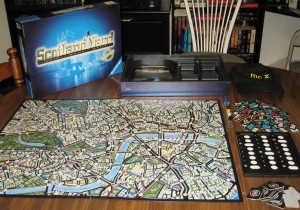I recently reviewed an old favorite of mine called Clue: The Great Museum Caper and thought I would keep with the theme by taking a look at a similar game called Scotland Yard.
Editor’s Note: Playing the game is possible with two players, despite what the box says…more about that in the review section of this article.
In Scotland Yard, one player takes on the role of Mr. X, who must avoid the detectives who are trying to capture him. Mr. X and the detectives will be traveling around London via various modes of transportation, which serve as clues as to where Mr. X may be heading. Mr. X must evade capture until the detectives run out of transportation tickets to play.
Let’s take a quick peek at the components and gameplay before heading into the review.
Components
Board – The board is a map of London with numbers scattered throughout. In between those numbers are various colored lines, which indicate the modes of transportation both sides can use to get from one location to the other.
Player Pieces – There are six player pieces, one of which belongs to Mr. X and is used when he surfaces.
Starting Station Cards – These cards are used to randomize everyone’s starting location at the beginning of the game.
Tickets – Tickets come in a few varieties, representing the modes of transportation that are available for players to use to move around the board. There are taxi, bus, and underground tickets, as well as special black Mr. X tickets.
Travel Log and Paper Insert – Mr. X will be using this log to track his movements secretly.
Visor – The game comes with a hat, which is given to Mr. X so that the detectives cannot see where he is looking when he is planning his movements.
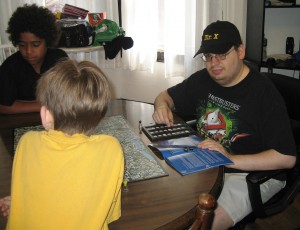
A Mr. X hat and a Ghostbusters T-shirt…all I need is a lightsaber in one hand and a phaser in the other, and I’m set.
Setup & Gameplay
Mr. X receives a small number of transportation tickets, the visor and travel log, two double move tickets, and a black Mr. X ticket for every detective player playing the game. The detectives receive a larger number of transportation tickets, though as they use them, they will be giving them to Mr. X for him to use.
The detectives draw a random starting station card and place their character tokens on the board. Mr. X draws a random starting station card as well but does not place his character token.
Mr. X always starts a round, using a transportation ticket to move. Once he has done so, he writes down the number station he is currently at in his log and places the ticket he used on top it so that it is covered up. The detectives follow suit until they all have moved, giving the tickets they have used to Mr. X in the process. The round ends after everyone moves, and the process repeats.
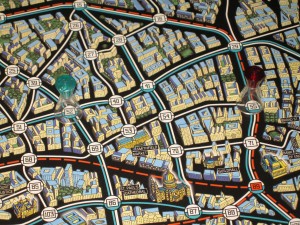
Both green and red can move via taxi (white) or bus (blue) to an adjacent station, assuming that they have the appropriate ticket.
On certain rounds, Mr. X is forced to show himself, but disappears again right before moving. Mr. X will have access to double move tickets and black tickets, the former of which lets him move twice and the latter of which conceals which method of transportation he used…these will help balance the odds considerably.
When the detectives run out of tickets and haven’t caught Mr. X, then Mr. X wins. If the detectives manage to land on him before they run out of tickets, then they win.
The Review
First, I promised to cover how the game is played with two players at the beginning of this review. When there is only one person playing the role of detective, I allow them to control three, four, or five pawns…the more pawns, the higher the difficulty for Mr. X. If two people are playing the role of the detective, I allow them to control two each, or three and two, if I want a challenge. If three people are playing as detectives, I allow one of them to control an extra one…and so on and so forth. Since Mr. X does not take turns in between the detectives, having more detectives will help box him in sooner and limit his movements. It’s important to give each detective pawn their own set of tickets.
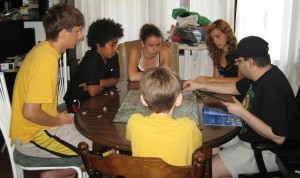
Even with five detectives on your side, you still need to pay attention to what tickets Mr. X is using.
Now, with all of that said, Scotland Yard is a fun game to play. I still prefer Clue: The Museum Caper over it, but it is still worth playing in its own right. The components do their job well and the learning curve is relatively small. It is definitely a game that kids or people who are new to gaming could jump into. My only complaint is in the board itself…the numbers are all over the place and it takes a while to find the one you are looking when you are placing your pawn on your starting location. If there is a pattern or method to that madness, I’m not seeing it.
I think I enjoy being Mr. X more so than the detectives, mainly because I have the ability to make the game as hard or as easy as I want it to be. If I see that the kids are having a rough time locating me, I’ll move closer to them so that my options are more limited when I surface next. As the detectives, I truly don’t know where Mr. X is, and could stumble on him early on and make the game not all that enjoyable.
The kids partially enjoyed playing this game and were often engaged in conversation and speculation as to where I was. Some of them did comment however that they liked Clue: The Great Museum Caper better, and Devonn (11) mentioned that there just wasn’t enough to do. I think he was bored with it, honestly, and needed more of a challenge. Anthony (16), Carolyn (13), and Carolyn’s friend all agreed that playing as Mr. X was a lot more fun than playing as the detectives. Oh, and their final agreed consensus…I apparently don’t look good in a hat. Haters.
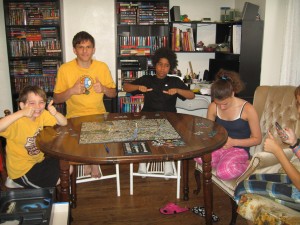
Two thumbs up, one “meh”, and two too engrossed in their cell phones to care. Make of that what you will.
Overall, the game is family friendly and would make a somewhat adequate alternative to Clue: The Great Museum Caper, considering how hard it is to find. For those of you who enjoy a little deductive reasoning and like a good “hide and seek” game, you’d do well to look into this game a little further. It’s limited play options might bore some, though it will keep you thinking.
Final Verdict: 6/10
—

